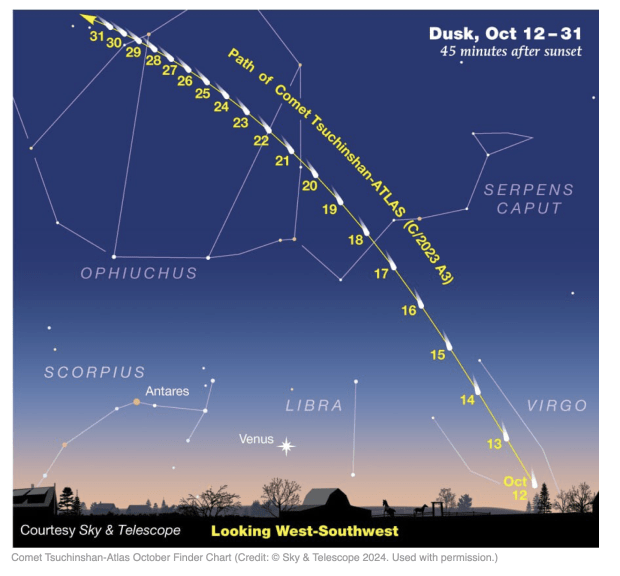
There’s still time to see a spectacular comet, before it’s too late
If you’ve missed a glimpse of the bright comet streaking through the evening sky, it’s not too late to catch it again. Then it’s gone for thousands of years, perhaps forever.
The viewing period for ancient Comet C/2023 A3 — visible on the low western horizon, soon after sunset — began on Friday and will continue until around Halloween, before it fades from visibility.
To spot it, find a location free of fog, and uncluttered by trees, mountains, tall buildings or bright lights.
While visible with the naked eye, binoculars help. It’s safe to look directly at the comet, unlike the sun, according to astronomer Andrew Fraknoi of the University of San Francisco’s Fromm Institute. Look for something fuzzy that’s a little above, and to the right, of the bright glow of planet Venus. By Oct. 21, it will be directly above Venus.
The nucleus of the comet was brightest on Monday and is now growing more faint. But its dramatic tail seems to grow longer because our perspective changes, said Alex Filippenko, professor of astronomy at UC Berkeley.
It is also climbing slightly higher on the western horizon, so it will be more visible for a longer time each evening before sinking below the horizon, he said. The bright light from the moon, which is full on Oct. 17, may make it more challenging to spot, but conditions should improve as the moon shrinks and skies darken.
“So, don’t look at it just one evening — keep monitoring the comet!” Filippenko said.
When and where to see the bright Comet Tsuchinshan-ATLAS between Oct. 11 through Oct. 21 as it rises higher into the sky and becomes more visible against darker skies.Sky & Telescope illustration (used with permission) Sky & Telescope
Also known as Comet Tsuchinshan–ATLAS, after the names of the Chinese and South African observatories that discovered it, it is ancient celestial traveler, originating from an invisible cosmic cloud beyond our solar system, far beyond Pluto.
“When the solar system formed, janitorial services were not very good,” joked Fraknoi. “We had a lot of debris left over from making the sun.”
This debris created rocky asteroids and icy comets, which fall toward the sun.
Occasionally, there’s a collision — and a chunk of ice breaks loose. That ice, a comet, establishes an orbit around the sun.
Sunlight bounces off all the dust and debris in its tail, causing intense brightening.
There were no guarantees that we’d see it. Astronomers predicted that Comet C/2023 A3 might perish during its closest transit past the sun on Sept. 27. That was the fate of two other significant comets. Comet Kohoutek, which offered a glimpse in 1973, broke up while passing too close to the sun. In 2013, Comet Ison was broken up by the sun’s intense heat and gravity.
But Comet C/2023 A3 survived. And now it’s a mere 44 million miles away.
By early November, the comet will soar away from us, lost to the unaided eye.
Then where does it go?
Related Articles
Some amazing things are going on above our heads. This moon isn’t one of them.
The Perseids are here. Here’s how to see the ‘fireballs’ of summer’s brightest meteor shower
Ever see a star explode? You’re about to get a chance very soon
Perseids meteor shower on view Aug. 12 in Santa Clara Valley
“Astronomers are in disagreement about how long its journey is, and how long it’s going to take to come back,” said Fraknoi. One estimate says it’ll return in 80,000 years, but that’s uncertain. Perhaps it’s gone forever.
“We’re still learning about it,” he said.
How to take a photo:
A three-second exposures with hand-held smartphones may reveal it. If you have a digital camera, put it on a tripod and take a four to 20 second exposure. The website https://www.space.com/comet-tsuchinshan-atlas-bright-night-sky provides additional useful information.


